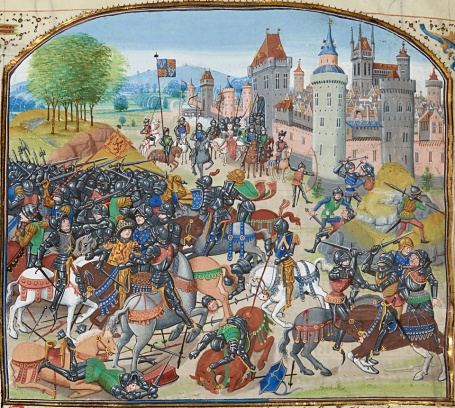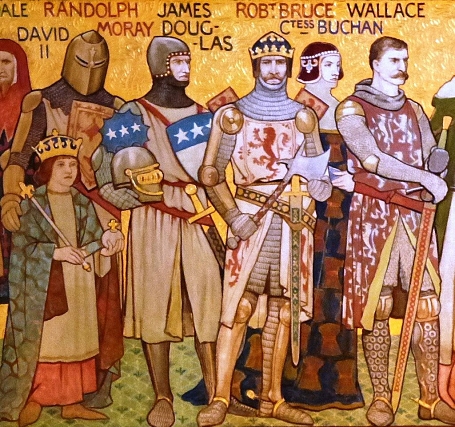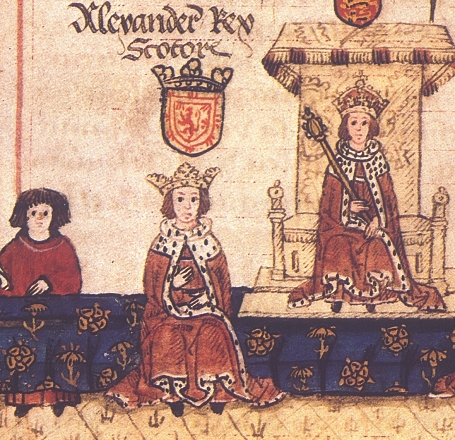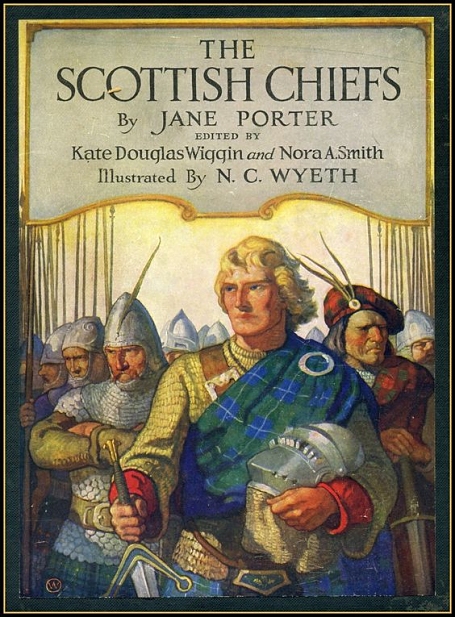The Life and Heroick Actions of the Renoun'd Sir William Wallace,
General and Governour of Scotland
by William Hamilton of Gilbertfield
Synopsis
The ballad begins with a stanza about the Scots and their gallantry in defending their nation against the Picts, Danes and Saxons. William Wallace's family background is then given, followed by a brief summary of his patriotic attributes. Wallace's father, Malcolm was "of honourable and true Scottish blood;" his mother was the daughter of the Sheriff of Ayr, Sir Ranald Crawford. An older brother, also named Malcolm, is mentioned.
A brief explanation of how the war between the Scots and English began is then given: King Alexander was thrown from his horse at Kinghorn in Fife, leaving a question and debate as to who should follow him to the throne. The competition between Baliol and Bruce was so heated that, in order to avoid a civil war, King Edward I of England was brought in to mediate.
Edward chose Baliol, with the stipulation that Baliol would swear fealty to Edward as his overlord. Baliol agreed. Soon after, Baliol was commanded to appear at an English Parliament where he was accused of contumacy (contempt of court, resistance to authority.) He went back to Scotland, only to be followed by Edward and a warband who, with the assistance and support of Earl Patrick of Dunbar, sacked the town of Berwick, killing thousands, then moving on to do battle at Dunbar, where many Scottish nobles were taken prisoner.
King Edward and Earl Patrick head north to Scone where Baliol is stripped of his crown, taken prisoner and transported to England. Scotland is left without a king and is at the mercy of Edward of England, who also removes the ancient and revered Stone of Scone, upon which Scotland's kings have been crowned for centuries, as a trophy.
William Wallace's father takes his eldest son to Lennox; Wallace, still young, goes with his mother to Kilspindie in the Carse of Gowrie to stay with his uncle. Wallace's uncle sends Wallace to Dundee for an education. Wallace is sixteen at this time and distressed and angry at the hold the English (the "South'rons") have on Scotland.
One day, Wallace goes into the town of Dundee where he meets up with the constable's son, Selbie. Selbie insults Wallace and demands his knife. Wallace says no, he uses it to cut his food. Selbie reaches for the knife, Wallace grabs him by the collar, draws his knife and stabs Selbie. Selbie's friends chase Wallace through the town. Wallace, still clutching the bloody dagger in his hand, runs into an inn he's familiar with, pleading with the goodwife to help him. She dresses him in women's clothes – gown and kerchief that covers his head and neck – and sits him in the corner to spin wool.
In the meantime, the English who hold Dundee have been searching throughout the town for Wallace. They finally come into the inn, but don't recognize Wallace sitting in the corner, spinning and singing. He stays at the inn until nightfall when the woman takes him, through a back way, out of town to his mother and uncle. Wallace's mother is in despair at the trouble he's gotten himself into; he tells her that he believes the Scots should "manfully withstand" the English.
Back in Dundee, the English issue a decree stating that Wallace is no longer allowed in the town – he's become an outlaw. To safely escape the area, Wallace and his mother disguise themselves as pilgrims, with Wallace hiding a small sword beneath his clothes, and head south. When asked their business, they say they're going to the shrine of St. Margaret at Dunfermline.
Wallace and his mother travel with other pilgrims – some of them English – to Dunfermline, cross the Firth of Forth to Linlithgow, then move on to Dunipace where they meet with a priest, also named Wallace, who tells them there are great troubles in the land, and asks them to stay at Dunipace for their own safety. Wallace says no, he wants to be at home if there's going to be trouble. Arriving back in Ellerslie, Wallace's mother sends for her brother, Sir Ranald Crawford, the Sheriff of Ayr, who tells her that her husband and oldest son, Malcolm, were killed at Lochmabane by the English. Sir Ranald then tells Wallace's mother that he'll speak with the English Lord Percy on their behalf to grant them protection.
The letter of protection arrives, but Wallace refuses it for himself. Crawford then arranges a safe place for Wallace with his uncle Richard Wallace, in Riccarton. In February Wallace goes to stay with this uncle who, though blind, was known for his wisdom and courage.
In April, Wallace goes fishing in the Irvine Water, taking only a boy with him to carry his net. They fish successfully, and after awhile note Lord Percy and his men riding by, making Wallace regret that he'd left his sword at home. Five of Percy's men see Wallace, ride over to him and demand the fish. Wallace offers them half, but they want it all. One of the men dismounts, takes all the fish from the boy. Wallace asks again for them to leave some behind, telling them that if they're gentlemen, they'll leave some for his uncle, an elderly knight. The Englishman tells Wallace they're taking them for their Lord, and there are plenty more for him to catch, to which Wallace replies, "Thou art in the wrong."
The Englishman rushes at Wallace, sword in hand, but Wallace knocks him to the ground with a staff, takes the sword and kills him. The other four Englishmen dismount and attack, but Wallace fends them off, eventually killing two. The other two flee on horseback, leaving the fish behind.
Wallace takes the horses that were left behind and returns to his uncle with the fish. His uncle tells Wallace that no one must know it was him who killed the Englishmen; Wallace replies that he can no longer stay at Riccarton. His uncle gives him a purse of gold and tells him when it's gone, send for more.
Wallace rides to Auchterhouse, then the Lagland Wood, and finally to Ayr. He leaves his horse by the woods and walks to the center of town. In the market square there is a huge Englishman who boasts that he's stronger than three Scotsmen put together. For a groat (a silver coin worth four English pennies), he'll let anyone who wishes take a stroke at him on the back with a staff. Wallace, amused and intrigued, offers the man a shilling. The man agrees and Wallace hits him with such force that the man dies instantly. Wallace is suddenly surrounded by Englishmen bearing swords. He kills two with the staff, draws his own sword and clears a path through the town, killing three more Englishmen along the way.
Wallace returns to the Lagland Woods where an unnamed benefactor from Auchterhouse sends provisions. After a time, Wallace returns to Ayr again, where he sees his uncle's (Ranald Crawford's) servant buying fish.
Crawford's servant stands at the fish stall, having purchased the fish and is approached by Lord Percy's steward, who demands the fish for his master, telling the servant he can buy more. Wallace, overhearing, confronts Percy's steward and asks the reason for such rudeness. The steward strikes Wallace with a staff; Wallace pulls out his knife and kills the steward. Quickly, eighty well-armed Englishmen surround Wallace. Wallace draws his sword and runs through the town, fighting them off as he flees. He kills several before his sword breaks. Wallace is taken prisoner and thrown into jail.
There is no chance of ransom (bail) given the number of Englishmen Wallace has killed in the town during his last two visits, not to mention the fact that he's still wanted in Dundee for the killing of Selbie, so Wallace languishes in the castle jail.
The food Wallace is given in prison would "kill and poison even a sow," and his health deteriorates so rapidly that he says a prayer, confesses his sins, and asks God to save Scotland from the English, as his strength is spent and he's no longer able to fight, nor seek revenge for the deaths of his brother and father.
Such is his decline that when the jailers arrive to take him for sentencing, they believe him to be dead and, reporting this to their superiors, throw Wallace's body over the castle walls. He lands in a soft spot, and his body is soon retrieved by his childhood nurse, who takes him to her house.
While bathing him, the nurse discovers that Wallace isn't dead after all. She tends to his wounds, and nurses him back to health, suckling him at her breast like a baby. She further protects him by letting word continue to pass through town that he's dead and weeping in sight of others.
During this time Thomas the Rhymer, a seer who had prophesized King Alexander's death, is visiting a priest in Ayr. The priest's servant has been at market and seen Wallace's body cast over the wall. He informs the priest and his guest of the news. Thomas the Rhymer then states that Wallace isn't dead. The servant tells that he saw the woman take Wallace's body away. The priest, upon Thomas' refusal to believe that Wallace is dead, sends his servant to the woman's house. The servant sees Wallace and returns to the priest, whereupon Thomas the Rhymer gives a prophecy about Wallace: Before Wallace dies he will rescue Scotland from the English three times.
Wallace, having recovered sufficiently to ride, sends the nurse and her family to Ellerslie before he sets out himself, armed only with a rusty sword he found in a nook of the house. He wants to go see his uncle, Sir Ranald, but fears that the English may catch him in Ayr, so decides to go back to his uncle Richard Wallace in Riccarton.
Along the road he meets up with three Englishmen, and pulls back. Suspicious of his behavior, they confront him, saying he must be a spy or a thief. He replies that he is ill and for them to let him be. Longcastle, the Englishman in charge of the party, becomes more suspicious of Wallace's behavior and draws his sword. Wallace draws his sword and with a single blow, cuts Longcastle's neck in two.
The soldiers dismount and Wallace immediately kills one; the other flees. Wallace goes after him and kills him, then then takes their horses, armor, weapons and money. He then continues on his way to Riccarton, where he enjoys a homecoming attended by his uncle Richard, cousins, his mother, Robert Boyd, and his uncle, Ranald Crawford, who was informed that Wallace was alive by the nurse as she was leaving Ayr.
The ballad, The Life and Heroick Actions of the Renoun'd Sir William Wallace, General and Governour of Scotland, by William Hamilton of Gilbertfield, 1722, is in the public domain.

The Kingdom of England and the Kingdom of Scotland fought dozens of battles with each other. They fought typically over land, particularly Berwick-Upon-Tweed, and the Anglo-Scottish border frequently changed as a result. Read more at Wikipedia.

The First War of Scottish Independence was the initial chapter of engagements in a series of warring periods between English and Scottish forces lasting from the invasion by England in 1296 ... Read more at Wikipedia.

Edward I (1239-1307), also known as Edward Longshanks and the Hammer of the Scots, was King of England from 1272 to 1307. Read more at Wikipedia.

Digitized version of The Scottish Chiefs, by Jane Porter, a novelization published in 1921 by Charles Scribner's Sons, about William Wallace and the First Scottish War of Independence. Read online at archive.org.